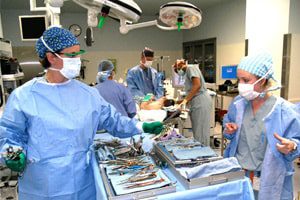
In some clinical trials, human being are being used as the placebo, with participants undergoing surgeries to determine a medical device’s efficacy, but without the benefits. The trials are all U.S. Food and Drug Administration- (FDA) approved. During drug trials, some participants receive placebo drugs, while other participants receive the actual drug. Researchers then measure […]
 In some clinical trials, human being are being used as the placebo, with participants undergoing surgeries to determine a medical device’s efficacy, but without the benefits. The trials are all U.S. Food and Drug Administration- (FDA) approved.
In some clinical trials, human being are being used as the placebo, with participants undergoing surgeries to determine a medical device’s efficacy, but without the benefits. The trials are all U.S. Food and Drug Administration- (FDA) approved.
During drug trials, some participants receive placebo drugs, while other participants receive the actual drug. Researchers then measure results. When drug trials are conducted, the placebo group is not subjected to the medication undergoing the testing and those who are being treated with the placebo are receiving some sort of potential benefit. In so-called “sham surgery” medical device placebo testing, participants become the placebo and are subject to invasive and dangerous surgical procedures, but with no potential for surgical benefit.
In fact, recent, major research conducted for a new cardiovascular device exposes how patients in a sham surgery placebo group undergo unnecessary medical procedures. In this case, the placebo patients received anesthetic drugs, were inserted with a large-bore catheter into a major artery, and agreed to be injected with a dye into their bloodstreams, The Wall Street Journal reported. Surgeons operated for about one hour, as a monitor revealed bogus results via radioactive fluoroscopy.
The patients agreed to angiogram procedures not knowing if they would be in the placebo or treating group, as part of the FDA-approved research of a new Medtronic medical device. The device, wrote The Wall Street Journal was developed to treat patients diagnosed with significant high blood pressure that is resistant to traditional drugs. Some patients received legitimate surgery while some did not and were randomly processed in bogus surgery. In other words, the patients were the placebos.
The methodology, according to The Wall Street Journal report, is something the FDA is actively pursuing, but does come at great expense and unclear benefits. This means that it could take many years before new products ever reach patients. In recent years, the FDA has encouraged device makers to use the dummy surgical approach. In fact, The Wall Street Journal noted that Clincialtrials.gov indicates that dozens of similar studies are also underway.
It is the FDA’s stand that the sham surgeries provide researchers with more bias-free and statistically superior results. Others question use of the very invasive procedures that are used in the sham surgery model. Those opposed to the sham surgery medical device testing approach note that while use of sham surgery may be beneficial in minimally invasive procedures in which very low risk devices are being tested, the process is not always appropriate. For instance, use of a sham as part of a planned surgery in which the sham would be a step in a broader procedure that does, in fact, benefit the patient, should be considered ,The Wall Street Journal wrote.
Research involving increased risk or harm, with no benefit, is also in conflict with the overarching principles that oversee human research. In fact, according to The Wall Street Journal, some of these principles are discussed in the Declaration of Helsinki, a global treaty involving the conduct of medical research. Consider that experiments used in sham surgeries involve patients agreeing to receive unneeded anesthetics, radiation, abdominal incisions, endoscopy, and rectal injections, to name some. The Wall Street Journal also notes that unnecessary incisions subject people to anesthesia and infection risks.
To address the ethical issues, the FDA will permit placebo patients to join the treatment group at some point; however, that might involve a second surgery. Second surgeries are often not desired by patients and are always more costly. The high cost of sham surgery trials, in general, also impacts domestic innovation with medical device firms seeking less expensive avenues, The Wall Street Journal also indicated.


